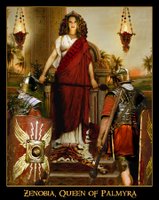
Palmyra: "Little is known of the Palmyrene community before 41 BCE. Its wealth was enough to excite the cupidity of Mark Antony, who ordered a cavalry raid against it. All that the Palmyrenes did was to evacuate their city and flee with their valuables across the Euphrates. This was the first recorded contact between Rome and Palmyra.
When the Emperor Valerian was conquered and captured by the Persians, his unworthy son left him in the hands of the conquerors; but Odeinathus, a citizen of Palmyra, marched against them, defeated them, and took the whole province of Mesopotamia. The services thus rendered to Rome were considered so great that Odeinathus was associated in the empire with Gallienus. This brave man was poisoned at Emesa; but he bequethed his power to a worthy successor - Zenobia, his widow. Unfortunately, ambition prompted her to usurp the high sounding title 'Queen of the East'. But Rome could brook no rival. Her army was defeated, her desert city laid in ashes, and she herself in fetters to grace the victor's triumph.
The expansion of the Parthian empire into the Euphrates region in the mid-second pre-Christian century created a new situation in the Near East. So did the annexation of Syria by Rome about three-quarters of a century later. Between these two world empires stood Palmyra, it's isolated location in the heart of the desert put it outside the reach of the Roman legions as well as the Parthian cavalry. Its merchants benefited by its unique position as the main halting-place on the trans-desert crossing of the north-to-south and east-to-west routes. Its politicians shrewdly exploited its strategic situation between the two great rival powers and, by siding one time with Rome and another with Parthia, kept the balance of power and profited by neutrality. By playing one adversary against the other, they maintained the independence of their city as a bufffer state.
It was not easy for the desert city to preserve full sovereignty in face of the growing ascendancy of the empire on its west. By the start of the Christian era Palmyra must have acknowledged the suzerainty of Rome, judging by imperial decrees of 17-19 CE, under Tiberius, regarding its customs duties, but never surrendered its independence. About the same time the city apparently received a resident representative of Rome and allowed one of her citizens, Alexandros, to undertake a mission on behalf of Rome to Sampsigeramus of Hims. Trajan incorporated it in the province he created in 106 and Hadrian on his visit in 130 granted it the name Hadriana Palmyra as a vassal of Rome. Palmyra's dependent cities also became Roman vassals. At the beginning of the third century Palmyra received colonial rights from Septimius Severus or some other empror of the Syrian dynasty in Rome."
*Thumbnail image "Zenobia Queen of Palmyra" by Howard David Johnson, illustrator.
 delicacies,
delicacies,